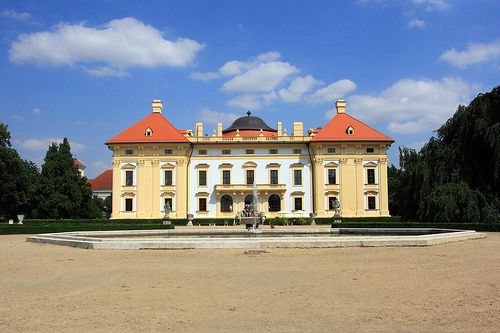

Location: Palackého náměstí 1 Map
Tel. 544 221 204
Open: Apr- May, Sep- Nov: Tue- Sun
Jun- Aug: daily
Designed by Domenico Martinelli
Official site
Slavkov Castle, also known as Austerlitz Castle, is a prominent Baroque palace located in the town of Slavkov u Brna in the South Moravian Region of the Czech Republic. The castle is renowned not only for its architectural grandeur but also for its deep historical ties to the Napoleonic era, particularly the Battle of Austerlitz in 1805. Spanning over 115 rooms and set within expansive French-style gardens, it stands as one of the best-preserved chateaus in Moravia and serves as a national cultural monument today. The site has evolved from a medieval fortress to a symbol of aristocratic opulence, reflecting centuries of noble ownership, architectural innovation, and pivotal European events.
The origins of Slavkov Castle trace back to the early 13th century
when the Teutonic Knights (Order of German Knights) established a
commandry on the site around 1200, with the first written mention of
Slavkov appearing in 1237. This early structure served as a Gothic
castle and the seat of their Bohemian bailiwick. By the early 16th
century, the property passed to the Kaunitz family, an ancient Moravian
noble house whose coat of arms featured a water lily. In 1509, Oldřich z
Kounic (Ulrich von Kaunitz) acquired the manor, making it the family's
primary residence for over four centuries.
The Kaunitz family
significantly transformed the estate. In 1590, they rebuilt it in a
Renaissance style, but the most dramatic changes occurred in the late
17th and 18th centuries. Construction of the current Baroque palace
began in 1696 under the direction of Italian architect Domenico
Martinelli, commissioned by the family. The project spanned over 50
years, with Prince Wenzel Anton von Kaunitz-Rietberg overseeing its
completion in 1769. Wenzel Anton, a key figure in the family, served as
chancellor to four Habsburg rulers, including Maria Theresa, and played
a diplomatic role in European politics, notably facilitating the
marriage between Louis XVI of France and Marie Antoinette to reconcile
Austria and France.
The castle's history took a dramatic turn during
the Napoleonic Wars. On December 2, 1805, the Battle of Austerlitz (also
called the Battle of Slavkov or the Battle of the Three Emperors)
unfolded nearby, where Napoleon Bonaparte's French forces decisively
defeated the allied armies of Austria-Hungary and Russia, resulting in
tens of thousands of casualties. Following the victory, Napoleon
celebrated at the castle, announcing his triumph from its balcony and
reportedly sleeping there. The armistice between Austria and France was
signed in the castle's oval ceremonial hall, known as the "Historic
Salon," on December 6, 1805, cementing its place in military history.
The Kaunitz line ended in 1919 with the death of Eugene Kaunitz, after
which the property passed to the Hungarian Pálffy family. Post-World War
I, the estate was confiscated from the aristocracy and placed under
state ownership. In 2008, it was declared a national cultural monument
and is now owned by the town of Slavkov u Brna.
Slavkov Castle exemplifies Baroque architecture, characterized by its
grandeur, symmetry, and ornate details. Designed by Domenico Martinelli,
the palace features a massive structure with 115 rooms arranged around a
central axis. The facade is imposing, with classical elements such as
columns, pilasters, and decorative pediments that reflect the influence
of Italian Baroque styles prevalent in the Habsburg Empire.
Interior
highlights include intricate frescoes by painter Joseph Pichler,
adorning the chapel and the ceremonial hall. The most distinctive
architectural feature is the oval-shaped "Historic Salon," a unique
central hall that serves as the castle's ceremonial heart. This room's
elliptical design, combined with elaborate stucco work and paintings,
creates a sense of dramatic space and historical resonance.
The
castle's gardens, established in 1774, are laid out in the French
Baroque style, modeled after the Gardens of Versailles. These expansive
grounds include manicured parterres, fountains, statues, and Baroque
alleys, providing a harmonious extension of the palace's opulence. The
overall design emphasizes axial symmetry, with long vistas leading from
the castle to the horizon, enhancing the sense of grandeur and control
over nature typical of Baroque landscaping.
Beyond its architecture, Slavkov Castle boasts several notable
features that draw visitors. The "Historic Salon" remains a focal point,
preserved to evoke the armistice signing and Napoleon's presence. The
castle houses a small historic museum dedicated to the Battle of
Austerlitz, featuring artifacts, documents, and a multimedia
presentation that brings the events of 1805 to life. Other exhibitions
include displays of faience pottery and period furnishings that reflect
the Kaunitz family's lifestyle.
The chateau park offers scenic walks
through its Baroque alleys, adding to the site's appeal as a cultural
and recreational destination. Temporary art exhibitions are also hosted,
showcasing various collections in the well-preserved halls.
Today, Slavkov Castle is open to the public as a museum and cultural site, managed by the town of Slavkov u Brna. It is one of South Moravia's top attractions, welcoming visitors to explore its halls, gardens, and exhibitions. Amenities include wheelchair-accessible entrances, a coffee shop, restaurant, and souvenir shop. For detailed opening hours and ticket information, visitors are advised to check the official website. The castle continues to host events, making it a living testament to Czech history and Baroque elegance.